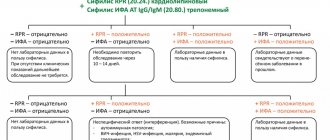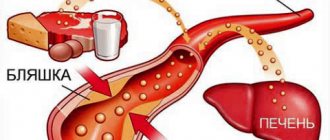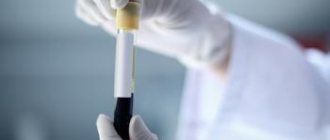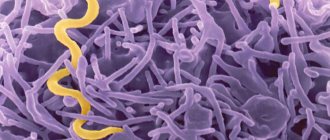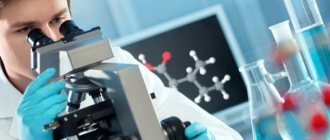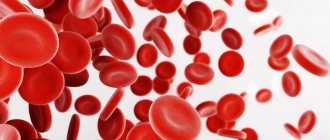- September 10, 2019
- Child's health
- Karina Perevalova
A general (or clinical) blood test is the most frequently prescribed laboratory test, during which it is possible to determine whether any pathological process is occurring in the body of a child or adult. In addition, it can be used to control the course of chronic ailments.
Clinical examination of liquid connective tissue is both a nonspecific and universal test. This is due to the fact that its results can be correctly interpreted only taking into account the patient’s symptoms.
Both infants and older children are faced with the need to regularly submit biological material for research. Below we describe how to correctly take a general blood test for a child, and what nuances need to be taken into account when preparing for the test. In addition, information is provided on how to correctly interpret the study results.
Indications
A clinical blood test is the most common type of laboratory diagnosis, based on the results of which conclusions can be drawn about the general condition of a person. In pediatrics, this test is especially important, because parents cannot always determine what really hurts their children.
Examination of just a few milliliters of liquid connective tissue can confirm or exclude the presence of a pathological process in the child’s body. Repeated analysis allows you to assess the degree of effectiveness of the treatment carried out earlier.
There are many conditions for which a clinical blood test is suspected to be particularly valuable. These include:
- Infectious pathologies of an inflammatory nature. They can have different etiologies (bacterial, viral, fungal) and localization. Most often, a general blood test is performed in children if they have symptoms of respiratory, skin and intestinal diseases, in particular helminthiasis.
- Inflammatory pathologies of non-infectious etiology. These include allergic and autoimmune diseases.
- Anemia.
- Blood loss resulting from injury.
- Impaired coagulation of liquid connective tissue.
- Pathologies of a malignant nature, which can be either congenital or acquired.
In addition, a general blood test is prescribed to assess the effectiveness of the treatment and before admission to educational institutions (kindergartens, schools).
Decoding the biochemical blood test
1. Indicators of total protein and fractions.
In the results of biochemical analysis and clinical research, the amount of total protein and proteins, that is, its fractions, is necessarily assessed.
At least 160 different proteins can be found in the blood, which are combined into three protein fractions (according to functions and composition): globulins (4 types), albumins, fibrinogens.
Without proteins, the body cannot function properly. However, their content in a biochemical blood test is below normal, indicating that the liver, which is responsible for the production of proteins, is not capable of synthesizing them. This, in turn, may indicate diseases associated with this organ. In addition, such indicators can cause:
- low protein diet (fasting, vegetarianism, diet with limited protein foods);
- parasitosis, in particular helminthic infestations;
- blood loss caused by heavy menstruation, external or internal bleeding due to injury or illness;
- extensive skin burns;
- kidney disease with excessive release of proteins during urination, proteinuria of the gestational period, etc.;
- hepatitis, cirrhosis with reduced protein synthesis;
- long-term use of glucocorticosteroids;
- development of malignant tumors of the stomach and bladder;
- poor absorption of nutrients in the intestine with colitis, enteritis, celiac disease and pancreatitis;
- ascites, pericarditis and ascites accompanied by plasma accumulation.
To diagnose diseases associated with parenchymal organs in a patient, identify rheumatism, and also if there are signs of the development of neoplasms, the doctor pays attention to the concentration of albumin in the blood. It can also be used to judge the effect of hormonal drugs and the consequences of fasting and dieting on the body.
If the indicators of the protein fraction of albumin in a biochemical blood test in an adult are below normal, this may indicate the development of nephrotic syndrome, renal or liver failure, the presence of tumors of the digestive system, cardiospasm, processes of tissue breakdown, paracentesis, lymphorrhea, exhaustion, etc.
2. Nitrogen metabolism.
When conducting a basic biochemical blood test, as a rule, creatinine and urea are examined, and other components related to low molecular weight nitrogenous substances (residual nitrogen, uric acid, ammonia) are added if it is necessary to verify or refute the presence of other pathologies and disorders.
The functioning of living organisms is always accompanied by the breakdown of cells and tissues, during which the production of nitrogenous compounds occurs. When, according to the results of the study, a deviation from the norm is observed, we can talk about disturbances in the functioning of the liver (nitrogen compounds are synthesized during the breakdown process), kidneys (accumulation due to poor filtration and incorrect excretion in the urine), and increased breakdown of proteins caused by various factors.
| Connection name | What does exceeding the norm indicate? |
| Urea | Hepatic or renal failure, hypertension, exposure to toxic substances, compartment syndrome |
| Creatinine | Severe lesions and diseases of parenchymal organs, impaired functioning of the adrenal glands, tumors, diabetes mellitus |
| Uric acid | Leukemia, gouty syndrome, anemia with vitamin B12 deficiency, dermatitis, poisoning, acute infectious process, liver disease |
If there is a decrease in nitrogen compounds in the blood, this may indicate liver failure, polyurine, hypothyroidism, prolonged fasting, or poor metabolism. In addition, such indicators can occur after hemodialysis and with the administration of intravenous glucose.
3. Carbohydrates in the blood.
Glucose is the main marker of carbohydrate metabolism occurring in the body. If a biochemical analysis shows an increase in the indicator, this indicates that the person has diabetes or a condition preceding it. However, in some cases, such results can occur due to burns, injuries, consumption of large amounts of sugar, and poor preparation for the test. Sometimes an increased amount of glucose in the blood is observed in diseases associated with the liver or pancreas.
To identify disorders of carbohydrate metabolism, in addition to assessing blood glucose, doctors may prescribe a determination of the amount of glycated or glycolyzed proteins (glycolyzed hemoglobin, glycated albumin (fructosamine), glycated lipoprotein).
If glucose levels in a biochemical blood test are below normal, this indicates hypoglycemia, if higher, this indicates hyperglycemia.
| Possible causes of hypoglycemia | Possible causes of hyperglycemia |
| Poor nutrition, fasting and dieting | Diabetes mellitus type 1 and 2 |
| Diseases associated with the gastrointestinal tract that cause poor absorption of carbohydrates (colitis, enteritis, etc.) | Injuries, brain tumors (often pituitary gland) |
| Hypothyroidism | Tumor neoplasms, diseases of the adrenal cortex |
| Liver diseases | Thyrotoxicosis, diseases associated with the thyroid gland |
| Long-term uncontrolled use of drugs containing insulin, as well as hypoglycemic medications | Epileptic syndrome |
| Encephalitis, meningitis, meningoencephalitis | Increased excitability, psycho-emotional instability |
| Insufficiency of adrenal cortex function | Long-term treatment with glucocorticosteroids |
4. Pigments in biochemical blood analysis.
As a result of combining with iron, chromium or copper, some types of proteins acquire a specific color. As they break down, bilirubin is released into the blood, which can be in free or indirect form. Further, during certain processes, it is transformed into a bound state.
In a biochemical blood test, three hemoglobinogenic pigments are identified, namely total, direct (conjugated, bound) and indirect (unbound, free, unconjugated) bilirubin. All of them can indicate the presence of diseases or pathologies in the body. In this case, special attention is paid to free bilirubin, since it is toxic.
An increase in pigment in the blood can occur as a result of genetic diseases, organ or tissue transplantation, or blood transfusions. The basis of diagnosis is the ratio of bilirubin fractions. For example, if elevated levels are observed, this may indicate diseases of the biliary tract or liver.
5. Bilirubin.
After bilirubin passes through the gallbladder and liver, it ends up in the intestines. Here it is converted into urobilinogen compound, that is, a pigment that colors feces and urine.
If the gallbladder, liver or bile ducts are not working well, then some of the bilirubin may remain in the human body. As it spreads through the tissues, they will turn yellow. The well-known name “jaundice” arose precisely because of this symptom. However, many are mistaken when they associate this disease only with hepatitis A. At the moment, jaundice can appear for three reasons:
- Due to poisoning of the body, including toxic, hemolytic anemia and pathologies of the spleen with concomitant hyperfunction. When the pigment protein breaks down too quickly, unbound bilirubin is produced in such quantities that the liver cannot process it. As a result, it begins to accumulate in tissues and blood.
- Due to liver failure caused by injury, hepatitis, tumors and cirrhosis, when the organ cannot process the required amount of bilirubin.
- This can be observed in diseases such as cholelithiasis, cholecystitis, acute cholangitis and tumors. All of them lead to the fact that the outflow of bile from the gallbladder is hampered due to compression of the pathways, and bilirubin flows back into the blood, and then into the tissues.
Total bilirubin is one of the main indicators of a biochemical blood test. As a rule, to diagnose diseases such as liver cirrhosis, jaundice, hepatitis of various etiologies, when characteristic symptoms appear, a specialist examines the level of fractions, that is, bilirubin (unbound and conjugated).
6. Lipids.
No less important indicators in a biochemical blood test are those that indicate the content of fats (lipids). They, in turn, make up the lipid spectrum. During the study, the specialist evaluates the level of lipoproteins (high, low density), which are commonly called “bad” or “good” cholesterol, total cholesterol and triglycerides. Based on the data obtained and the ratio of components, the atherogenicity coefficient is determined. If there is a need to clarify the diagnosis, an additional study is carried out to determine the amount of phospholipids.
We recommend
Anti-wrinkle facial massage: 10 effective techniques More details
7. Cholesterol levels.
In an adult who has no health problems, the level of total cholesterol in a biochemical blood test should be in the range of 3.0–5.2 mmol/l, with 40–60% of it being considered “good.”
Cholesterol in the body can be contained in the form of a high molecular weight compound with proteins and low molecular weight. High-density lipoproteins, produced largely in the liver, are involved in the regulation of processes associated with hormones, the psycho-emotional state, as well as in the formation of the cell membrane, etc.
If we talk about low and very low density lipoproteins, they enter the human body most often with food. Over time, these compounds begin to accumulate in blood vessels and turn into cholesterol plaques. This in turn leads to the fact that the lumen of the vessel becomes narrower, and the blood supply to organs and tissues decreases. However, even in the case of destruction of lipoprotein accumulations, there is a danger that their fragments can lead to the formation of blood clots.
| Increased total cholesterol | Lowering total cholesterol |
| Poor nutrition, diabetes, obesity, myocardial infarction, hypertension, alcoholism, ischemia, gestation period, cholelithiasis, etc. | Liver pathologies, malnutrition, hyperthyroidism, gastrointestinal diseases in which lipid absorption is difficult, chronic obstructive pulmonary disease, rheumatoid arthritis |
8. Enzymes.
When it comes to enzymes in a biochemical blood test, these are most often “liver tests”, amylases, ALT and AST. If an extended study is carried out, then this list increases significantly.
9. Analysis for “liver tests”.
ALT levels, that is, alaminoninottransferase, provide information regarding how efficiently the liver works in the body. In some cases, they talk about problems with the heart muscle or skeletal muscles.
A blood test for the level of AST (aspartatominotransferase) is performed if there is a suspicion of diseases and pathologies of the liver, heart (rheumatic carditis, myocardial infarction, angina), as well as infectious inflammatory processes.
10. Alpha amylase and pancreatic amylase.
Without the presence of these enzymes in the blood, the breakdown of complex carbohydrates would be impossible. For diagnostic purposes, a biochemical blood test examines the concentration of amylase, and the indicators can be either below normal or above it.
As a rule, an increase indicates the presence of diseases associated with the pancreas. In some cases, a high concentration of amylase may indicate viral hepatitis, mumps (endemic mumps), alcoholism, and renal failure. In addition, an excess of amylase in the blood is observed with long-term use of glucocorticosteroids and tetracycline drugs.
Based on a drop in values below normal in a biochemical blood test, the following diseases and conditions can be diagnosed:
- thyrotoxicosis;
- gestational toxicosis accompanying the first trimester of pregnancy;
- necrosis of pancreatic tissue;
- myocardial infarction.
11. Creatine kinase and its fractions.
Based on the concentration of the creatine kinase enzyme in the blood, the specialist assesses how efficiently energy metabolism occurs in the tissues of the heart (CF), muscles (MM fraction), and brain (BB). Indicators above normal indicate that there is accelerated tissue breakdown. In order to diagnose myocardial infarction, understand how much tissue is affected, and also make a prognosis, the CF subtype of creatine kinase is used.
12. Lipase.
Lipase is responsible for the breakdown of neutral fats in the human body. Also, to obtain a more accurate diagnosis and information regarding how affected the organ is, the pancreatic lipase indicator is used, which is more valuable in terms of information content than amylase.
Contraindications
If your child visits a massage therapist, it is necessary to complete the course or reschedule the date of collection of biological material. In addition, it is unacceptable to donate blood immediately after an X-ray examination, ultrasound or any physiotherapeutic procedures.
There are no absolute contraindications to the analysis. However, if a child suffers from certain diseases, in particular blood clotting disorders, low blood pressure, difficulties may arise during the collection of biomaterial. The nurse must be warned about this in advance.
Preparation rules
This stage is very important. Parents should be responsible for preparing for the study. If you do not take into account some nuances before collecting biomaterial, the interpretation of a general blood test in children may subsequently be carried out incorrectly. It is important to understand that liquid connective tissue reacts very sensitively to any changes.
Basic rules of preparation:
- Stop taking medications 14 days in advance. For example, if the child was treated for a completely different reason. If canceling the appointment is impossible, you must inform the doctor about this. The doctor will take this information into account when interpreting the results of the child’s general blood test.
- The day before and on the day of delivery of the biomaterial, it is necessary to avoid physical activity. It is recommended to take your baby for a walk before bedtime, and then put him to bed. For older children, you can read a book the day before, get a massage, or play calm games.
- If the blood sugar concentration is important to the doctor, you should not brush your child’s teeth in the morning. Older children should be prohibited from using chewing gum.
- After waking up, it is recommended to drink a glass of clean water without carbon. Information regarding whether to take a general blood test for a child on an empty stomach or not is presented below.
The psychological aspect plays a very important role. It is extremely important to prepare the child for the blood sampling process itself. If the child is older than 1 year, you can already try to explain to him that everything will go quickly and painlessly.
Clinical examination of liquid connective tissue is a highly sensitive indicator that allows you to detect even the slightest malfunction in the functioning of internal organs. At the same time, ignoring the need to comply with preparation rules can lead to false results.
1. General blood test.
Before taking a general blood test, the last meal should be no earlier than 3 hours before the blood draw.
2. Biochemical blood test.
To determine cholesterol and lipoproteins blood is taken after a 12-14 hour fast. Two weeks before the study, it is necessary to discontinue drugs that lower blood lipid levels, unless the goal is to determine the lipid-lowering effect of these drugs.
To determine the level of uric acid in the days preceding the study, it is necessary to follow a diet: avoid eating foods rich in purines - liver, kidneys, limit meat, fish, coffee, tea as much as possible in the diet. Intense physical activity is contraindicated.
Blood donation for hormonal testing is carried out on an empty stomach (preferably in the morning; if this is not possible, 4-5 hours after the last meal in the afternoon and evening). On the eve of the test, high-fat foods should be excluded from the diet, and the last meal should not be large.
The results of hormonal studies in women of reproductive age are influenced by physiological factors associated with the stage of the menstrual cycle, therefore, when preparing for an examination for sex hormones, you should indicate the phase of the cycle and adhere to the recommendations of your doctor about the day of the menstrual cycle on which you need to donate blood.
Hormones of the reproductive system in women are tested strictly according to the days of the cycle:
- LH, FSH - 3-5 days;
- Estradiol - 5-7 or 21-23 days of the cycle;
- progesterone 21-23 days of the cycle.
- prolactin, 17-OH-progesterone,
- DHA sulfate, testosterone - 7-9 days.
- Blood for insulin and C-peptide is given strictly on an empty stomach in the morning. Thyroid hormones, insulin, C-peptide are given regardless of the day of the cycle.
In men, reproductive hormones are released in the morning (8-9 am).
Before donating blood for stress hormones (ACTH, cortisol) , you need to calm down, when donating blood, get distracted and relax, since any stress causes an unmotivated release of these hormones into the blood, which will lead to an increase in this indicator.
The requirements for donating blood when testing for infections are the same as when studying a hormonal profile. Blood is donated on an empty stomach (in the morning or 4-5 hours after the last meal in the afternoon and evening, and this last meal should not be heavy, and high-fat foods should be excluded from the diet the day before the test). The results of tests for the presence of infections depend on the period of infection and the state of the immune system, so a negative result does not completely rule out infection. In doubtful cases, it is advisable to re-test after 3-5 days.
A blood test for the presence of antibodies of the IgG, IgM, IgA classes to infectious agents should be carried out no earlier than 10-14 days from the moment of illness, since the production of antibodies by the immune system and the appearance of their diagnostic titer begins during this period. At an early stage of the disease, seroconversion occurs (absence of antibodies during the acute period of the disease).
Before donating blood for viral hepatitis , 2 days before the test, it is advisable to exclude citrus fruits, orange fruits and vegetables from the diet.
Before donating blood for coagulation studies, you must inform your doctor about taking anticoagulant medications.
Features of infant nutrition before biomaterial collection
Many parents are concerned about the question of whether to take a general blood test for their child on an empty stomach or not. Doctors say that at the time the biomaterial is taken, the baby’s stomach should be empty.
As a rule, laboratories are open from early morning until 10-11 o’clock. In fact, this gap is quite enough to plan a visit to a medical facility.
As a rule, immediately after waking up, infants feel hungry. If a child wants to eat, there is no need to deny him this and quickly take him to the laboratory. In this case, the baby will experience enormous stress, and the doctor may receive unreliable test results.
If a child is under 1 year old, it is useless to explain to him why he was not fed before a procedure that was scary for him. Breakfast for infants is required. Porridge, milk, lean meat, vegetables - any dish from his usual diet can be offered to the baby. Then you need to take a three-hour break.
Doctors recommend that parents adhere to the following algorithm:
- Wake up your baby early.
- Feed him. Before a general blood test, the child can eat any food that is familiar to him.
- Go for a walk with your child or play at home.
- After 3 hours, go to the laboratory and submit the biomaterial for research.
Thus, before a general blood test, the child can eat. But after finishing the meal, you must wait 3 hours and only then go to the laboratory.
You can drink clean water in moderate portions. All liquids containing sugar, dyes and preservatives are prohibited. It is unacceptable to drink tea, fruit drinks, compotes and decoctions.
HORMONES
Blood for hormonal studies must be donated on an empty stomach in the morning. If this is not possible, blood can be donated for some hormones 4-5 hours after the last meal in the daytime/evening hours (except for those studies for which blood must be donated strictly in the morning). 1-2 days before the test, exclude high-fat foods from the diet; the last meal should not be large. 1 day before the study, psycho-emotional and physical comfort (calm state without overheating and hypothermia) is necessary.
Thyroid hormones
During the initial check of thyroid hormone levels, discontinue medications that affect thyroid function 2-4 weeks before the test (after consultation with your doctor). When monitoring treatment, exclude taking medications on the day of the study and be sure to note this on the referral form (also note information about taking other medications - aspirin, tranquilizers, corticosteroids, oral contraceptives).
Sex hormones
In women of reproductive age, the results of hormonal studies are influenced by physiological factors associated with the phase of the menstrual cycle. When examining sex hormones, indicate the phase of the menstrual cycle.
Hormones of the reproductive system must be taken strictly on the days of the cycle:
LH, FSH – 3-5 days of the cycle; Estradiol – 5-7 or 21-23 days of the cycle; Progesterone – 21-23 days of the cycle; 17-OH-progesterone , DGA-sulfate, testosterone – 7-9 days; Prolactin - donate blood in the morning at rest; before the study, exclude palpation of the mammary glands.
Anti-Mullerian hormone (AMH/MIS), Inhibin B
For women, the study is carried out on days 3-5 of the menstrual cycle. 3 days before taking blood, avoid intense sports training. The study should not be performed during any acute illness. Do not smoke 1 hour before taking blood.
Adrenaline and norepinephrine
8 days before the study, exclude medications: salicylates, β-blockers. 1 day before the test, you must refrain from heavy physical activity, exclude alcohol, coffee, tea, B vitamins, and bananas.
Renin, angiotensin
Before the study, exclude the use of estrogens (1-2 months before), diuretics (3 weeks before), and antihypertensive drugs (one week before). Blood collection should be carried out in a sitting or standing position.
Aldosterone
In consultation with your doctor, 8 days before the study, discontinue antihypertensive drugs, β-blockers, laxatives, corticosteroids, diuretics, and antidepressants. 3 weeks before the study, discontinue aldosterone antagonists.
ACTH, cortisol
Due to the fact that ACTH and cortisol are stress hormones, you need to calm down and relax for 20 minutes before donating blood. Any stress causes an unmotivated release of these hormones into the blood, which will lead to an increase in this indicator. The level of these hormones changes cyclically throughout the day, so the most informative results are studies conducted in the morning before 9 o’clock.
Insulin, C-peptide
Donate blood strictly in the morning.
Gatrin 17, Gastrin-17 stimulated, pepsinogen I, pepsinogen II, H. Pylori IgG
Blood must be donated for testing on an empty stomach after a 12-hour fast. 1 week before the study, refrain from taking medications that affect gastric secretion: Pepcedin, Zantac, Nizax, Ranimex, Esofex, Losec, Somac, Ranixal, Ranil. 1 day before the study, refrain from taking medications that neutralize hydrochloric acid secreted by the stomach: Alsucral, Balancid, Prepulsid, Metropam, Librax, Gaviscon. If you have difficulty stopping medications, be sure to inform your doctor. 3 hours before donating blood, refrain from smoking.
Nutritional features of children over 1 year old
In this case, the child will have to undergo a general blood test on an empty stomach. This rule is unbreakable. It applies to children over 1 year of age and adults. The fact is that the doctor needs to obtain indicators that reflect the actual functioning of the internal organs.
Eating any food before collecting biomaterial will affect the results of the analysis. Due to this, the doctor may interpret them incorrectly. The worst thing is that, due to parental negligence, the doctor may make an incorrect diagnosis and prescribe an inappropriate treatment regimen.
For example, a child had breakfast in the morning and went to the laboratory. About an hour later he donated blood. At this time, food components have already entered the liquid connective tissue and provoked changes in its composition. They affected blood viscosity, the ratio of proteins, fats and carbohydrates, and the leukocyte formula. After the study is completed, the conclusion form will be sent to the attending physician. The doctor will see certain signs and conclude that an inflammatory process is occurring in the child’s body. Then the doctor will prescribe treatment. Therapy can pose a danger not only to health, but also to life. That is why it is extremely important for parents to know how to properly take a general blood test for a child and follow all established preparation rules.
BIOCHEMISTRY
Urea
1-2 days before the study, you must follow a diet: stop eating foods rich in purines - liver, kidneys, and also limit meat, fish, coffee, tea in your diet as much as possible. Intense physical activity is contraindicated.
Cholesterol, lipoproteins
Two weeks before the study, it is necessary to discontinue drugs that lower blood lipid levels, unless the goal is to determine the lipid-lowering effect of therapy with these drugs.
Glucose
When donating blood for glucose (in addition to the basic requirements for preparing for tests), you should not brush your teeth, chew gum, or drink tea/coffee (even unsweetened). A morning cup of coffee will dramatically change your glucose levels. Contraceptives, diuretics and other medications also have an effect.
Glucose tolerance test
It is carried out only if there are preliminary results of determining glucose on an empty stomach, without load. The glucose content in blood plasma is determined on an empty stomach and 2 hours after a glucose load. It is necessary to follow a normal diet (with a carbohydrate content of more than 125-150 g per day) and adhere to the usual physical activity for three days before the study. The study is carried out in the morning on an empty stomach after an overnight fast for 12-16 hours (during this time you should not smoke or drink alcohol). During the study, the patient should lie or sit quietly, not be overcooled and not engage in physical work. It is not recommended to conduct research after and during stress, after operations and childbirth, during inflammatory processes, alcoholic cirrhosis of the liver, hepatitis, during menstruation, and in gastrointestinal diseases with impaired glucose absorption. Before the test, it is necessary to exclude medical procedures and medications (adrenaline, glucocorticoids, contraceptives, caffeine, thiazide diuretics, psychotropic drugs and antidepressants). Discontinuation of medications is carried out only after preliminary consultation of the patient with a doctor.
for CHILDREN UNDER 14 YEARS OLD .
PREGNANT women are recommended to carry out a glucose tolerance test at 24-28 weeks, this allows identifying women with gestational diabetes with an accuracy of 98%.
Process of collecting biomaterial
Many mothers and fathers do not know where they get a general blood test from children. Both capillary and venous blood are suitable for the study. These species have different normal values, which must be taken into account when interpreting the results.
Where do they get a general blood test for children? Most often, by default, biomaterial is collected from a finger. But, according to clinical recommendations, if it is impossible to perform this action, the nurse has the right to make a puncture in the vein. It is worth noting that this happens extremely rarely.
Blood sampling for clinical research occurs as follows:
- The nurse wipes the pad of the finger of the non-working hand with cotton wool, generously moistened with an antiseptic. The latter most often is medical alcohol.
- The nurse then very quickly pierces the skin with a lancet or scarifier. Then she puts a little pressure on the pad of her finger so that a few drops of blood come out. This liquid connective tissue is removed with cotton wool soaked in an antiseptic.
- The nurse then collects the escaping blood and transfers it to a tube. Then cotton wool moistened with an antiseptic is applied to the puncture site. It needs to be held on the pad for several minutes. This is necessary in order to stop the bleeding.
The process of collecting biomaterial lasts on average 1 minute. It is necessary to explain to the child that it is not associated with the occurrence of severe painful sensations, but some discomfort may still occur.
Information on how to take a general blood test for a child can be provided by the doctor who ordered the test. He will subsequently be involved in the interpretation of the results.
Normal indicators
During the diagnosis, the laboratory technician takes into account the total volume of blood, counts the number of formed elements, and also evaluates their relationship with plasma and with each other. That is why decoding the result is difficult for people without medical education. Doctors do not recommend considering your own conclusions to be 100% correct and independently prescribing treatment for your child. This can lead to irreparable consequences.
The age of the child must be taken into account. The fact is that as children grow older, the norms for the results of a general blood test in children also change. Information about what indicators are normal for each age is presented in the table below.
If the child is completely healthy, all of these indicators will be within normal limits. If a pathological process occurs in his body, they will be deviated in one direction or another. It does not happen that only one indicator decreases or increases. That is why a comprehensive assessment of laboratory diagnostic results is important. Only a doctor can do this correctly.
Biochemical blood test indicators
It is not scary if the indicators obtained as a result of a biochemical blood test differ in each clinic, since there is a range of normal values. The final word regarding whether the indicators are considered low, high or acceptable always remains with the attending physician, who makes conclusions in accordance with the medical history.
Table of normal indicators for biochemical blood tests:
If we talk about what is included in a detailed biochemical blood test, then these are indicators both for preventive studies carried out periodically, and for identifying serious diseases and disorders. However, in the first case, there is no point in detailed biochemistry, as well as in the presence of certain symptoms and specific complaints. Additional indicators are included in the analysis depending on the health status of the person who consults the doctor.
The fact is that if a patient complains of extreme thirst, then first of all the amount of glucose in the blood will be checked. If the problem is high blood pressure, attention is paid to the lipid spectrum. In case of anemia, they look at transferrin, iron, ferritin, TIBC, that is, the iron-binding capacity of serum. If the doctor suspects problems with the liver, as well as hepatitis, then indicators such as bilirubin, liver enzymes (ALT, AST and alkaline phosphatase) are assessed.
Recommended articles on the topic:
- How to massage the abdomen for weight loss: different techniques for health and beauty
- Stone massage: description, benefits, methods
- MRI of three parts of the spine: when is it necessary and what are the features of the procedure
What diseases are indicated by deviations from the norm?
It is worth noting that this does not always happen due to a pathological process. Sometimes the reasons are natural. Or parents forgot how to take a general blood test for their child, and, for example, fed him immediately before visiting the laboratory. Both pathological and physiological causes are described below.
One of the most important indicators is hemoglobin. This substance is an iron-containing protein found in red blood cells. When its concentration in the blood decreases, it is customary to talk about anemia. This is a pathological process characterized by a deficiency of oxygen molecules in the body, as a result of which the functioning of all systems is disrupted.
Reasons for decreased hemoglobin levels:
- Unbalanced diet. Anemia is often diagnosed in children who do not receive proper complementary foods.
- Pathologies of the digestive organs.
- Infectious diseases.
- Helminthic infestations.
- Incompatibility of the blood of the fetus and mother during pregnancy.
- The process of destruction of red blood cells occurs in the body.
- Impaired hemoglobin production.
- Insufficient bone marrow development.
- Congenital pathologies of organs with hematopoietic function.
An increase in hemoglobin levels is diagnosed extremely rarely. The main reasons for this condition:
- Pathologies of the cardiovascular system.
- Impaired kidney function.
- Diseases of liquid connective tissue.
- Pulmonary fibrosis.
- Oncological diseases.
- Pulmonary heart.
- Presence of extensive burns.
- Being in a stressful state (more often detected in schoolchildren).
- Smoking in adolescence.
Red blood cells are the most important formed elements of the basic biological material of humans. Their main purpose is to deliver oxygen molecules to every cell of the body.
When the level of red blood cells increases, it is customary to talk about a condition such as erythrocytosis. The main reasons for its occurrence:
- Congenital heart pathologies.
- Disruption of the hematopoietic system.
- Heart failure.
- Impaired functioning of the adrenal cortex.
- Pathologies of the respiratory system (for example, chronic obstructive pulmonary disease, asthma, bronchitis, etc.).
- Oncological diseases.
- Diabetes.
- Hypertension.
- Any pathology, the course of which is accompanied by vomiting, diarrhea and fever.
- Itsenko-Cushing's disease.
- Splenectomy.
- Extensive burns.
In the presence of erythrocytosis, hemoglobin is always elevated.
If the concentration of red blood cells is reduced, doctors diagnose erythropenia. The causes of this condition may be:
- Bleeding, including chronic bleeding.
- Deficiency of folic acid, iron or vitamins.
- Chronic kidney failure.
- Severe intoxication of the body.
- Radiation or chemotherapy.
- Lymphoma.
- Leukemia.
- Glomerulonephritis.
- Myelodysplastic syndrome.
- Autoimmune pathologies.
- Presence of a tumor in the bone marrow.
- Aplastic type anemia.
- Regular consumption of contaminated water.
- Being under stress.
- Overwork (both mental and physical).
- Hunger.
- Uncontrolled use of medications.
It is worth noting that against the background of erythropenia, the level of hemoglobin always decreases.
The color index is a specific feature. It can be used to judge the ratio of red blood cells and hemoglobin.
If the color index is reduced, this may indicate the following ailments:
- Pathologies of the hematopoietic system.
- Kidney failure.
- Hemoglobinopathies.
- Intoxication of the body with lead or chemicals.
- Anemia.
If there is an increase, the doctor may suspect one of the following pathologies:
- Chronic hypoxia.
- Oncology.
- Diabetes.
- Diseases of the endocrine system.
- Liver damage.
- Anemia.
- Pathologies of the heart or lungs.
Reticulocytes are platelets, but only immature ones. Their number allows you to find out at what speed the composition of liquid connective tissue is renewed.
If reticulocytes are elevated, this may indicate the presence of internal hemorrhage, anemia, malignant damage to the hematopoietic system, hypoxia, inflammatory processes, and infectious diseases. In addition, this condition is often a consequence of an overdose of antipyretics. That is why it is always important to remember how to take a general blood test for children. It is not advisable to take medications before collecting biomaterial.
The concentration of reticulocytes can be reduced due to anemia, thyroid dysfunction, kidney disease, uremia, and infectious processes. In this case, most often there is a significant deviation from the norm. It is better to entrust the interpretation of a child’s general blood test to a doctor. Only a specialist will be able to find out the reason for the deviation.
Platelets are plates that are responsible for the process of coagulation and the formation of blood clots. Normally, a general blood test in children should contain at least 160 (180 in children). If they are deficient, the doctor may suspect a malfunction of the coagulation system, which often occurs with hemophilia and other hereditary pathologies. In addition, platelet deficiency can occur due to anemia, infectious diseases and oncology.
If platelets are much higher than normal, this may indicate the presence of a chronic inflammatory disease (an example is tuberculosis). In addition, the following conditions may cause thrombocytosis:
- Enhanced synthesis of these elements by megakaryocytes located in the red bone marrow. Most often this happens with erythremia.
- The process of platelet utilization is very slow. This may be a consequence of surgical excision of the spleen.
- Platelets are not distributed correctly in the bloodstream. As a rule, this condition is a consequence of mental or physical stress.
It is worth noting that the doctor only suspects the presence of a dangerous pathology if the platelet concentration exceeds 800 thousand/l.
One of the most clinically significant indicators is ESR. If an inflammatory process occurs in the body, red blood cells become heavier and their sedimentation rate increases.
Leukocytes are the main weapon of the body's defense system. Their deviation from the norm in a general blood test in children in 95% of cases indicates the presence of an infection in the body or a dysfunction of hematopoiesis. They have many types: basophils, eosinophils, neutrophils, lymphocytes, monocytes.
Complexes with this research
Advanced anti-aging diagnostics in postmenopause Advanced monitoring of age-related changes during postmenopause 19,860 ₽ Composition
Male anti-aging diagnostics Monitoring of key indicators in men aged 40+ 7,900 ₽ Composition
Prevention of childhood colds Examination of children aged 7+ who suffer from colds more than 4 times a year 1,560 ₽ Composition
IN OTHER COMPLEXES
- Advanced women's anti-aging diagnostics RUB 19,540
- Your immunity 1,990 ₽
- Future dad 4,990 RUR
- Examination during pregnancy. 3rd trimester 5,360 RUR
- Joining IVF RUB 14,350
Where to get a general blood test for a child, cost
A clinical study of liquid connective tissue is an analysis for which biological material can be submitted in any laboratory. Moreover, the results will be ready almost immediately.
You may want to contact your primary care physician first. He will issue the directions. In addition, he will tell you how to properly take a general blood test for a child. After this, you need to go to the treatment room and sign up for biomaterial collection. On the appointed day and time you need to come and donate blood for analysis.
In this case, the research will be free. You just need to present your medical insurance policy to the registrar.
You can take a general blood test for your child for a fee. In this case, you must choose any medical institution and come to the treatment room during its opening hours. Moreover, you don't even need a referral. This option is more attractive because it saves a lot of time. Moreover, the cost of the study is on average only 350 rubles.
